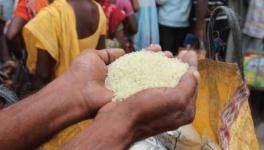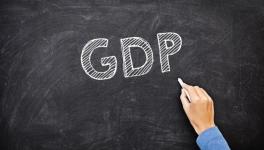Millennium Development Goals: A Travesty of Justice
“Poverty rates have reduced substantially in the world but the number of people in risk of falling into poverty has increased” announces the World Bank PovertyNet as world leaders gather in New York today to attend the UN summit on Millennium Development Goals (MDGs). The agenda for the summit has already been set. The latest UN review of the MDGs says:
"The world is on track to meet the MDG target of halving the proportion of people living on less than $1 a day between 1990 and 2015. Overall poverty rates fell from 46% in 1990 to 27% in 2005 in developing regions, and progress in many developing countries is being sustained. This is despite setbacks caused by the 2008-09 economic downturn and the effects of the food and energy crises."
The UN is apparently not satisfied by this progress. The Secretary General has reminded the world leaders of their Millennium Declaration pledge ‘for a better world’ adopted in 2001 and urged upon the international community to fulfil their promises. The unkept promises have been identified by the UN: a $152.7 billion deficit in official development assistance by the OECD donors vis-à-vis the UN target till 2009. The summit would therefore predictably end by further urging upon the rich countries to step up assistance to fill the aid ‘gap’ in order to match the MDG slogan: ‘We can end poverty’. So is poverty going to ‘end’? Let us take a closer look.
Sham of ‘Ending’ Poverty
The poverty reduction being claimed by the World Bank and the UN is based on the following finding:1
"Between 1981 and 2005, the share of the population in the developing world living below $1.25 a day was halved from 52 to 25%…reducing the number of poor by 500 million (from 1.9 billion to 1.4 billion) between 1981 and 2005."
How can the fact of 500 million people increasing their earnings beyond $1.25 a day, in a span of 24 years, be construed as a reduction of poverty? The same research also reports that in these 24 years the number of people earning less than $2 a day across the world remained unchanged at around 2.5 billion. Evidently, a bulk of those who have started earning more than $1.25 a day in these 24 years have continued to earn less than $2 a day. Therefore they have continued to remain in the ‘risk of falling into poverty’. But can those who are at the ‘risk of falling into poverty’ be at all considered to have moved out of poverty in the first place?
The problematic nature of this measure of poverty becomes clearer if we compare it with the poverty line of the US, the richest country in the world measured in terms of GDP. There is no single poverty line the US. Poverty estimates are done on the basis of household income thresholds, with different thresholds depending on the number of family members and dependents in a household. If we take the weighted average poverty threshold for a family of four in 2009 as a benchmark, the poverty line in the US stands roughly at $15 per day (per capita). The poverty line is a little less for households with higher family sizes, but even for the highest family size it would not be less than $13 per day (per capita). The poverty rate as per the latest findings of the US Census Bureau stood at 14.3% in 2009, up from 13.2% in 2008. The total number of poor people in the US increased from 39.8 million in 2008 to 43.6 million in 2009.2
Thus, poverty is increasing even in the richest country of the world, in terms of its official poverty line. And if everything else remains the same, the 500 million people living in the poor countries, who have moved from earning around $1 a day to $2 a day in 24 years as per the World Bank finding, will take at least another 264 years to reach the current minimum poverty threshold of the US at $13 a day. Yet, it is being claimed on the basis of this finding that ‘poverty rates’ are coming down.
The facts revealed by the latest stocktaking of the MDGs by the UN are more telling.3 The absolute number of people living in extreme poverty (below $1.25 a day) will be 920 million in 2015. The effects of the economic crisis will push an additional 64 million people into extreme poverty in 2010. Moreover, the absolute number of undernourished people increased from 817 million in 1990 to 830 million in 2007, i.e. an increase of 13 million. In effect, therefore, we are witnessing an increase in both poverty and hunger even as the world is supposedly ‘on track’ to meet the MDG target. What a sham.
Inane Discourse
What sustains this sham is the mainstream academic discourse on poverty, which evades any serious analysis of the causes behind it and obsessively revolves around issues of definitions and measurements. It is not that definitions and measurements of poverty are irrelevant. But making that the starting point of analysis serves the purpose of relegating the causes behind poverty to the background. The entire focus shifts to whether poverty has increased here or declined there and endless hair splitting on the direction and extent of change. When causes are at all discussed, they are done so within a framework, which through a chain of circular reasoning brings the discourse back to definitions and measurements of poverty. The question of causes gets buried in the process.
For instance, the first chapter of World Bank’s Handbook on Poverty and Inequality is titled ‘What Is Poverty and Why Measure It?’4 This chapter defines poverty as the ‘pronounced deprivation in well being’. What is well being? Conventionally, it is linked to whether ‘enough’ income or consumption is earned by people to put them above some ‘adequate minimum threshold’. This definition of threshold has been progressively expanded over time by including access to specific types of goods and services like food, housing, education and health. The latest approach further broadens the notion of well being to include ‘capabilities of the individual to function in society’, like ‘political freedoms’. The stated purposes of defining well being and measuring poverty is: “to keep poor people on the agenda…identify the poor people…target appropriate interventions…to help poor people”. But how do we ‘help’ poor people without understanding the causes of their poverty?
This comes in the eighth chapter of the Handbook, titled ‘Understanding the Determinants of Poverty’, which states that while a ‘poverty profile’ is only meant to describe the pattern of poverty and not explaining the causes of poverty, “yet, a satisfactory explanation of why some people are poor is essential if we are to be able to tackle the roots of poverty”. So at last we come to the roots. So what are they? We are served a whole menu of ‘main determinants’ of poverty, which are summarized by the authors themselves in a table (given below).
What is remarkable about this menu of ‘determinants’ of poverty is that it neither suggests any hierarchy within these myriad determinants, nor any cause effect relationship. As per the World Bank Handbook, poverty can be caused by anything, from typhoons and earthquakes to age or ethnicity. It may also be caused by lack of access to assets or lack of proximity to schools and clinics. It may perhaps be caused by the social structure and inequality too. We need to find out or establish through regression analysis, which of the determinants correlates better with poverty.5 We simply do not know yet.
To be fair to the authors of the Handbook, they are acutely aware of the vacuity of such analysis. They admit that “the ‘causes’ of poverty identified are ‘immediate’ (or ‘proximate’) causes, but not necessarily ‘deep’ causes”, and that while regression analysis can show lack of education as a cause behind poverty, it cannot explain why some people lack education. They further accept that “the weakest part of poverty analysis…is developing a clear understanding of the fundamental causes of poverty in a way that leads naturally to an effective strategy to combat poverty.” Yet, they justify their methodology in the following terms: “Because there is no reason to believe that the root causes of poverty are the same everywhere, country-specific analysis is essential.”
So there may be root causes of poverty. But these root causes are different for different countries. In order to get to those root causes, we have to do ‘country-specific analysis’. But if we do not have any a priori theory of the root causes of poverty, on what basis do we do the analysis? We go back to the first chapter of the Handbook on definitions and measurements of poverty. It is this circular reasoning which contributes to the inanity visible in the World Bank PovertyNet we noted at the beginning: “poverty rates have reduced substantially in the world but the number of people in the risk of falling into poverty has increased.”
Why is the international poverty line set at $1.25 per day? As per the World Bank’s explanation, it is the average of poverty lines found in the 15 poorest countries. But what accounts for the average poverty line of 15 poorest countries being set at $1.25 per day? The rich and affluent sections in many of these countries earn several hundred times more than that. Yet, the bare subsistence level in the poorest countries is set as the standard for international poverty. And even then, poverty alleviation targets are not being met. Just imagine the consequence of the entire poverty discourse, if the American poverty line of $15 per day is made the international poverty line.
Policy Cruelty
These conceptual inanities have grave repercussions for policy and the plight of the poor. Let us take the case of India, which is often showcased as a success story in today’s world. The national poverty line, obtained by weighting the World Bank’s $1.25 per day rural and urban lines with respective population shares, is Rs. 16.30 per day, as per which 41.6% of people in India are poor. However, the Indian Planning Commission’s poverty estimates for 2004-05, based on poverty lines of Rs 11.88 per day for rural areas and Rs 17.95 per day for urban areas, shows poverty in India to be only 27%. In contrast, the proportion of people not being able to acquire a minimum of 2,100 calories consumption in India is 62%, way above both the poverty estimates.6
What happens as a consequence of this unhealthy competition, between national and international policy establishments, to downplay and underestimate poverty? In India’s national capital Delhi, the below poverty line (BPL) population is estimated by the Planning Commission as only 2.29 million, which in a city of over 15 million population is a gross underestimate. Moreover, while only 418000 households in Delhi currently have BPL ration cards, a survey conducted by the Delhi Government (under its ‘Mission Convergence’) has already estimated over 800000 households (50 lakh people) residing in slums and resettlement colonies as ‘vulnerable’.7 The survey was conducted with the intent of identifying ‘vulnerable households’ and awarding them BPL cards. Yet, this huge number is still not being considered as BPL and provided access to subsidised food available through the PDS. Dividing the poor by drawing arbitrary poverty lines is only serving the purpose of denying basic entitlements like access to cheap food to large segments of the poor population. This injustice happens even as precious resources from the exchequer get expropriated by the powers that be under the cover of public funded jamborees of the elite like the Commonwealth Games.
India continues to be home to around 25% of the world’s hungry population currently estimated at 925 million by the UN World Food Programme. Nearly half of India’s children under three years of age continue to remain malnourished alongside half of pregnant mothers who are anaemic. And even as per capita cereal supply and consumption in India falls below that of the least developed countries (156 kg in 2008), 60 million tons of foodgrain stocks are being allowed to accumulate and overflow the granaries today, to rot or to feed the rats.8 Despite all this, the ruling dispensation in India, which thrives on the slogan of ‘inclusive growth’, continues to desperately latch on to its concepts of poverty, BPL and the targeted PDS. What underlies the veneer of MDG targets and ‘inclusive growth’, therefore, is a policy culture of cruelty and deliberate injustice towards the poor.
Two Ideas of Justice
The fundamental problem with the concept of poverty being used by the World Bank, UN or India’s Planning Commission today and its policy outcomes, lies in its underlying notion of justice. The problem arises because the principal cause behind poverty, which lies in the exploitation of labour by capital on the one hand and the poor countries by the rich on the other, are permanently shoved under the rug. The entire discourse on poverty is built by taking this exploitation for granted and shying away from discussing capitalism and imperialism.
Adam Smith, who authored one of the most celebrated of treatises in political economy, The Wealth of Nations (1776) – which justifies the individual self-interest driven order under capitalism because it creates wealth and leads to greater social good – also wrote The Theory of Moral Sentiments (1759) which termed the disposition to ‘despise’ or ‘neglect’ of poor persons as a ‘corruption of our moral sentiments’ and forcefully urged for more ‘sympathy’.9 Karl Marx, writing almost a century later, criticised Adam Smith’s views as that of a ‘fatalist’ economist; who looks at poverty merely as a birthpang of capitalism and not as one which gets reproduced alongwith wealth under capitalism; and who thereby remains ‘indifferent’ towards the ‘sufferings of the proletarians’.10 These divergent views on poverty arise out of two notions of social justice, which need to be contradistinguished.
Underlying Adam Smith’s framework is an apologetic notion of justice, based on the categories of ‘neglect’, ‘despise’, ‘sympathy’ and ‘moral sentiments’. If we try to develop these implicit notions of injustice and justice into explicit social objectives, the former would require an a priori identification of the aspects of ‘neglect’ of the poor, on whose removal the social effort needs to be channelised. The problem is that categories like ‘neglect’ are purely subjective and have no benchmark. What comprises ‘neglect’ would always vary, both across time and societies. Therefore, what is realizable as justice would forever remain loosely defined. And within this loosely defined framework of justice, it can never be concluded, whether justice is being or not being done. Needless to say, it is this framework that drives the MDGs today.
To this complacent moral universe of justice as apology, Marx’s notion of justice delivered an electric shock. Its superiority arose from the fact that by rigorously establishing the category of class exploitation as ensconced in the production process, it provided a firm anchor to social justice. The idea of justice was dragged out from the sphere of morality and ethics into the material sphere of production, distribution and ownership of wealth. Thus defined, the attainment of ultimate justice becomes the end of exploitation. Whether a society is more or less just, or moving towards more or less justice, can also be judged on the basis of whether there is more or less exploitation. In other words, the goalposts of justice cannot be shifted.
The acute relevance of Marx’s idea of justice today is borne by the emptiness of the mainstream academic and policy discourse on poverty. However, it is argued by some that the clarity in its notion of justice is also the main weakness of Marxism, because by taking a maximalist position – end exploitation to end poverty – it actually fails to achieve either, because ending exploitation entails a radical revolution against capitalist property. Since the revolution either happens or it doesn’t, there is nothing to do in between. This confusion arises from a misunderstanding of Marxism.
What Marxism does is to historicize exploitation under capitalism, by tracing its origins through the process of ‘primitive accumulation’ into the evolution of modern industrial capitalism. This demystification of the exploitation process enables concrete praxis on the part of the exploited against their exploitation, on the one hand, and universalises that praxis, on the other. Within this framework of justice, a whole body of socio-economic rights can be clearly conceived, struggled for and actualized over time, signifying progress towards ultimate justice. This framework, moreover, suggests that efforts to stabilise and ameliorate exploitation under capitalism through policy interventions can succeed only if struggles against exploitation simultaneously persist alongside those efforts, in order to ensure progress towards ultimate justice. In the absence of those struggles or in the case of their gradual decay, exploitation will once again intensify under the spontaneous tendencies of capitalism, snatching away extant rights and entitlements. The struggle against exploitation therefore becomes the bulwark of justice for the poor under capitalism.
There are of course serious forms of oppression and inequities which exist in society that are distinct from class exploitation – based on gender, caste, race, language or ethnicity. Marx, during his lifetime, did not deal with them independently. But what he did, and uniquely so, was not to limit the notion of social justice within the bounds of exploitative property and production relations. Marxism therefore creates space for the poor, cutting across gender, caste, race, language or ethnicity, to come together to struggle against their class exploitation, advance their rights and make progress towards a society free from such exploitation. It is the weakening of such struggles today – locally and globally, both on the ground and in the realm of ideas – which has not just made the discourse on social justice poorer but also robbed the discourse on poverty of all substance and vitality.
Conclusion
The exploited in the poor countries today; the poor peasants, the wage labourers, the unemployed and self-employed petty producers; continue to live a life of drudgery, insecurity and impoverishment, in the swamp of the informal sector. They are watching the cruel joke being played on them by the national and international policy establishments, in the name of ‘poverty reduction’, ‘inclusive growth’, ‘MDGs’ and so on even as rising prices of food and fuel eat away the pittance that they make after a very hard day’s work. And even those low paying jobs have been stolen away from many of them by the global economic crisis.
These two and a half billion plus people in the poor countries are yearning for freedom from their exploitation. They will not wait and watch endlessly. History and commonsense will inexorably drive them towards the next tide of revolutionary transformations in this century.
Notes
1. Shaohua Chen and Martin Ravallion, 2008, “The developing world is poorer than we thought, but no less successful in the fight against poverty”, Policy Research Working Paper 4703, World Bank, 2008
2. As per the Institute for Research on Poverty, University of Wisconsin-Madison, the total number of people living below the official poverty line in the United States (US) was 39.5 million (22% of population) in the late 1950s. This had declined to 23 million by the early 1970s (11%) but rose to 31 million by 2000 (11.3%). Since then it has gradually increased to 37 million in 2005 (12.6%) and further to 39.8 million (13.2%) in 2008. Primary source of data is the US Census Bureau. The poverty estimation methodology has been revised in the US four times since the 1950s, the last time being 1981.
3. MDG Report 2010, United Nations.
4. See Jonathan Haughton and Shahidur R. Khandker, Handbook on Poverty and Inequality
5. Regression analysis is a method of testing causal relationships between variables on the basis of statistical data.
6. The comparisons are from Himanshu, What Are These New Poverty Estimates and What Do They Imply? 25 October 2008, Economic and Political Weekly
7. See Dipa Sinha, “PDS in Delhi” and Albeena Shakil, “On Mission Convergence”, Commission Papers for Delhi State Conference, All India Democratic Women’s Association, September, 2010.
8. See Utsa Patnaik, “The Early Kalidasa Syndrome”, The Hindu, 13 September 2010. Also see Arindam Banerjee, “The Political Economy of Rotting Foodstocks”, 17 September 2010, http://www.pragoti.org/node/4130
9. Adam Smith, The Theory of Moral Sentiments Part I, Section III, Chapter III, 1759.
10. Karl Marx, The Poverty of Philosophy, “The Method”, 1847.
Get the latest reports & analysis with people's perspective on Protests, movements & deep analytical videos, discussions of the current affairs in your Telegram app. Subscribe to NewsClick's Telegram channel & get Real-Time updates on stories, as they get published on our website.























